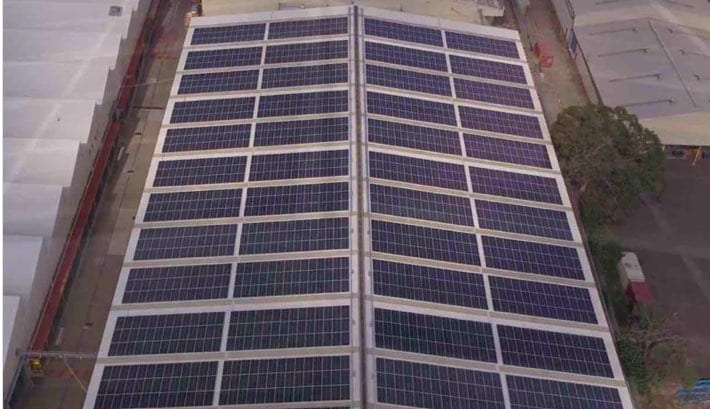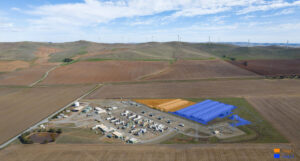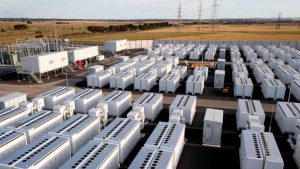A new policy proposal has been unveiled to use Australia’s commercial and industrial rooftops as a network of mini solar farms that store electricity in batteries during the middle of the day and send it to the grid at times of peak demand.
The “Business Power” concept, detailed in a discussion paper published on Tuesday by the Victoria Energy Policy Centre, argues for the development of a nationwide network of big rooftop PV that is capable of behind-the-meter trading in the electricity wholesale market.
The VEPC argues that the move could provide one quarter of the country’s generation needs, and usher out coal without the need for major new transmission works.
Correctly calibrating a framework – and keeping it out of the hands of existing energy regulators – would unleash huge volumes of new solar into the grid, says Victoria University professor Bruce Mountain, the director of the Victoria Energy Policy Centre and lead author of the policy blueprint.
Mountain, who has been vocal in his opposition to some of the major transmission projects being proposed to accommodate Australia’s shift to renewable energy, says the idea is motivated by the urgent need to replace coal generation without inflicting high social and local environmental costs.
He says using the hectares of existing rooftops across the country removes issues around social licence for changing land use, the need to build out new transmission lines, and the need to go through lengthy state and federal approvals processes.
And crucially, it will take up capacity in the up to 10 gigawatts (GW) of underused distribution networks, a figure that came out of number crunching earlier this year by software company Neara.
Suitably developed, the report says, this network of commercial and industrial solar rooftops might be expected to supply at least a quarter of Australia’s annual electricity consumption – and much of it when the sun is not shining.
“Rooftop solar is our second biggest clean energy resource and will probably soon be our biggest. I think [the premises of Australia’s commercial and industrial properties] has scope to be twice as big as that,” Mountain says.
“For the business sector we should orient policy toward turning them into mini power stations, so they supply the grid. Of course they will also self supply, that’s part of it, but the policy is designed to encompass that as well as grid exports, most notably outside the solar peak periods.”
The Business Power blueprint is relatively simple: charge a “solar feed-in floor price” before 11am and after 2pm of $100 per megawatt hour (MWh), and a “battery discharge floor price” between 6pm and 9pm of $200/MWh.
This would incentivise behind-the-meter, battery-backed solar power supplies into the grid before the peak day solar periods; the use of batteries to soak up supply during the middle of the day; and then the discharge of that battery during the evening peak.
Removing uncertainties
The report also argues that keeping the new framework out of the hands of existing regulators the Australian Energy Market Commission (AEMC) and Australian Energy Regulator (AER) is important to avoid conflicts of interest.
But as with any framework, Mountain notes there are uncertainties around the detail. The pricing structure may be too low or high, it might not actually reduce electricity prices, businesses may still not want to become involved in generating energy for the national network, and network providers may or may not like it.
He says opposition from network operators fearful of a new strategic threat could be headed off through government intervention.
“Some of the more strategically savvy will cotton on to the fact that this will make them more influential, and some of the more savvy state govts will see there is competition to be had.”
Mountain cites South Australia, which was forced to move quickly towards renewables in the early days of the Renewable Energy Target by “clapped out” coal generators and AGL’s chokehold on gas generation.
“As a proportion of RET payments, South Australia has by far got the biggest share of them.”
If the federal government were to implement the Business Power plan, Mountain expects some distributor networks to seize the chance to become strategic players, shipping power to and from lots of large customers rather than just passively taking electrons from a handful of big generators.
On cost, the analysis suggests this model of battery-backed rooftop solar is likely to be cost-effective compared to alternatives and that Business Power has a prospect of paying for itself in wholesale and retail price reductions, even after accounting for recovery of policy costs.
The analysis also argues this approach would be more efficient at incentivising more C&I solar uptake than the existing federal Small-scale Renewable Energy Scheme, which is in the process of being phased out and is limited to installations with a maximum capacity of 100kW.
In the four years to 2023, residential solar rooftop numbers have grown by about 2.5 GW annually, compared to commercial and industrial which have only added 500 MW a year, according to the Business Power report.
As an added bonus, the VEPC policy plan would provide incentives for behind-the-meter storage, too.
“While success is not guaranteed, there is good reason to be optimistic, and that little will be lost by trying,” the discussion paper says.
“Few energy policies offer this combination of potentially huge upside and easily managed downside risk. Policy makers, market participants and interest groups are encouraged to lose no time in their detailed consideration of this.”










